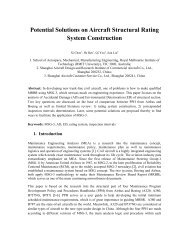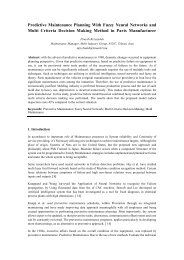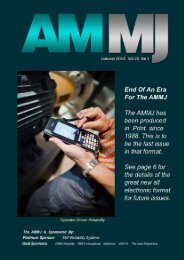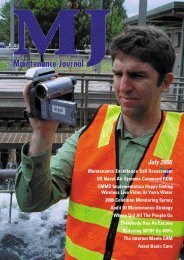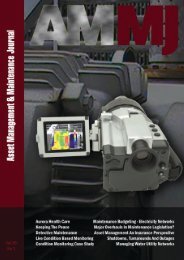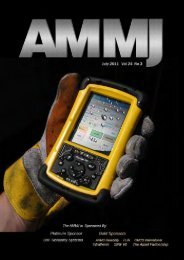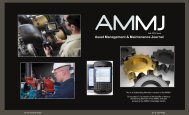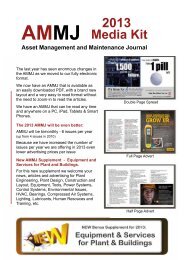DAY 1 - AMMJ
DAY 1 - AMMJ
DAY 1 - AMMJ
You also want an ePaper? Increase the reach of your titles
YUMPU automatically turns print PDFs into web optimized ePapers that Google loves.
IMPORTANCE OF SETTING LEVELS OFSERVICE FOR M & E PLANT ASSETSTHROUGH STRATEGIC ASSET MANAGEMENTFarshad Ibrahimi, farshad.ibrahimi@ghd.com.auTim Wood, tim.wood@melbournewater.com.auDon Vincent, don.vincent@ghd.com.auRobert Lau, robert.lau@melbournewater.com.auSummary: This paper outlines significance of setting level of service using strategic assetmanagement planning process. The paper also focuses on the benefits of strategic assetmanagement and demonstrates where the level of service fits from a strategic perspective. The levelof service is described from theoretical and practical point of view with emphasis on mechanicaland electrical plant assets. A case study is presented, which provides information on MelbourneWater’s experience of defining levels of service for mechanical and electrical assets of its largestsewerage treatment plants (the Eastern Treatment Plant) through the development of strategicasset management plans. This paper was presented at ICOMS 2008.INTRODUCTIONSuccessful and continuous operation of complex wastewater treatment plants such as Melbourne WaterCorporation’s (MWCs) Eastern Treatment Plant (ETP), depend largely on the mechanical and electrical (M &E) plant assets and the service they provide over their effective lives. MWCs ETP is a conventional activatedsludge wastewater treatment plant, which was commissioned in 1975. The plant treats approximately 350ML/d of sewage flows in Melbourne. The plant contains and is heavily reliant on a significant portfolio of M& E assets that are nearing the end of their effective lives.Integral to the plant operations is the development of strategic asset management plans for the currentand future management of these assets, which can be a complicated and challenging task in its own right.Strategic Asset Management Plans (SAMPs) are the “front line” of the Asset Management Systems asthey encapsulate the asset scope, identify required levels of service, (LoS) develop risk profiles, outlinethe operating context and management regimes and outline performance monitoring requirements for theentire plant or individual systems within the plant.The asset management framework defines the requirement for development of SAMPs and subsequently,the LoS is a requirement within the SAMP framework. LoS has been identified as the most critical element inthe SAMP framework as it helps determine the driver for all other aspects of the strategic planning process,such as risk assessments, defining operational regimes, measurement of performance, compliance withregulatory, OHS and environmental targets, and incident management through emergency responseplanning. To this effect, defining LoS clearly will facilitate Asset Strategy and Operations in delivering therequired LoS. That is; ‘Understanding WHAT service is required from the asset or system and subsequentlydetermining HOW that LoS can be delivered’.There are direct and indirect benefits associated with defining LoS, particularly those related to M & Etype plants. The development of SAMP framework is one of the key initiatives in meeting the MWCs assetmanagement objectives This paper will discuss the importance of defining LoS, and highlight experiencesfrom the development of SAMPs for the M & E assets of MWC’s ETP.BENEFITS OF STRATEGIC ASSET MANAGEMENTStrategic Asset Management enables effective management of assets by defining structured and controlledactivities associated with lifecycle costing, maintenance, operations and management of residual businessrisk exposure, to achieve dedicated or agreed LoS. SAMPs facilitate the link between the objectives definedin the Asset Management Framework and the day-to-day management of assets, through:• Understanding of required LoS.• Identification and mitigation of risks.• Development of appropriate operational and maintenance strategies.• Awareness of regulatory, OH & S requirements and legislations.• Management of incidents through adequate emergency response planning.A number of benefits associated with development of SAMPs, particularly those related to M & E typeassets, are highlighted below:




